How to Buy and Make the Best Holiday Sticky Ham
Wondering what you need to know before purchasing a holiday ham?? How to Buy and Make the Best Holiday Sticky Ham is a guide that provides all detailed information on how to choose and bake a ham that’s right for your dinner and skill level of cooking.
Be armed and ready before heading into the “land of hams” at the grocery store.
The Best Recipe Holiday Sticky Ham Recipe
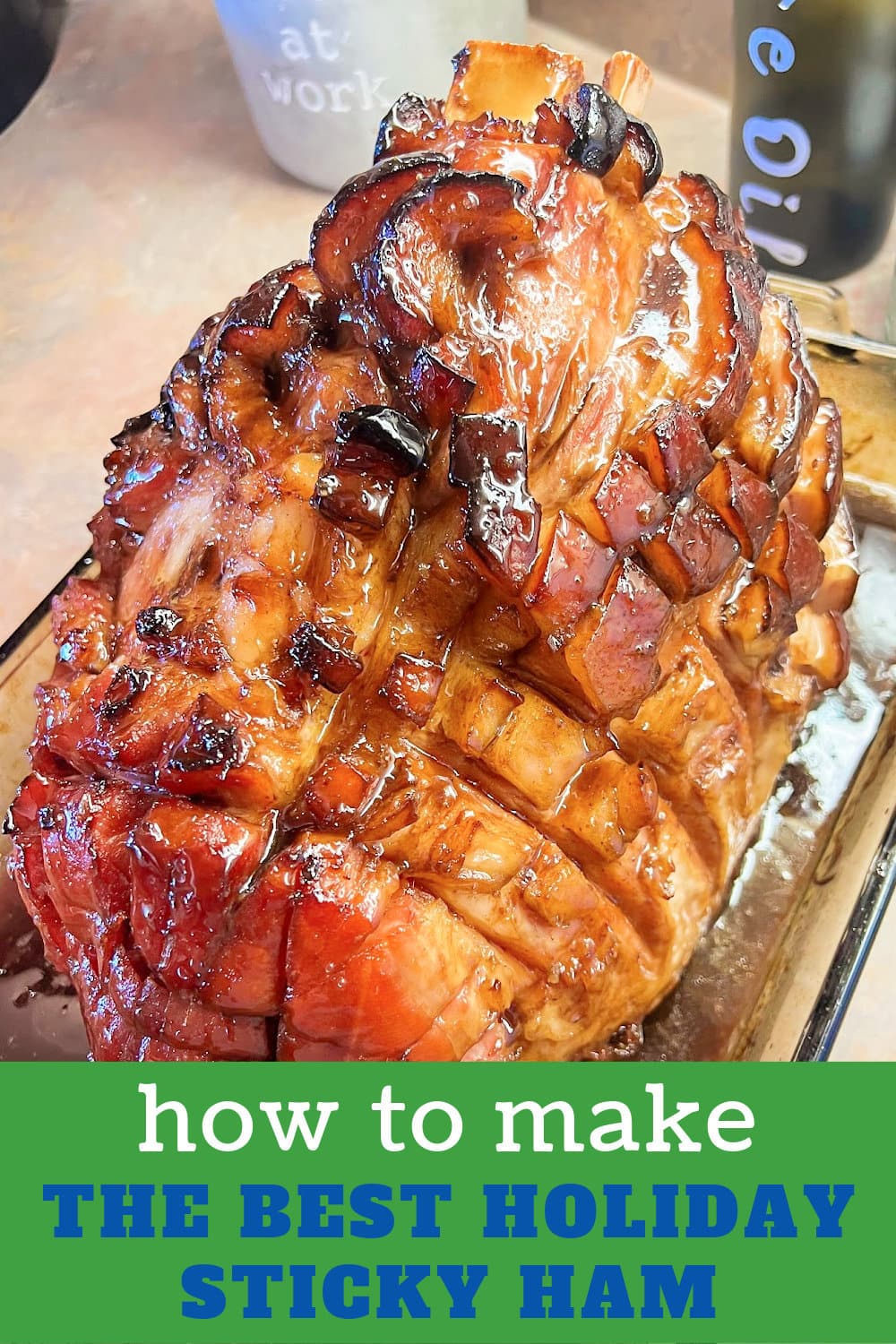
Howdy! Chef Alli Here. Let’s Get You Cookin’…. Shall We?? 🙂
Cooking ham is easy. Choosing ham, on the other hand, is sometimes not so easy. Let’s just put that out there right away.
Any ham confusion you encounter when making a purchase is not your fault! Deciding which ham to buy can be a challenge because there are quite a few different types and cuts of ham available, not to mention all the different ham terminologies that are used in recipes and on ham labels.
Save this Recipe
Enter your email address and we will send you this recipe to your mailbox for easy reference! Plus, we will send you our latest recipes every week!
Whew. It’s great to have options, but sometimes it can all be a bit overwelming.
But have no fear!! Because ham is perfect for holiday meals and easy to cook for big group entertaining any time of year, I want to arm you with the information you need to make a confident ham choice.
You can even cook this easy sticky holiday ham in a roaster oven!
What you’ll learn from this post –
- Let’s define what ham is
- Whole ham and half hams – what they are and where they come from on the pig
- Choosing between half hams – butt end vs. the shank end
- Bone-in ham vs boneless ham – the advantages and disadvantages
- Buffet hams
- Spiral cut hams
- Picnic hams
- The differences between cured ham vs. smoked ham vs. uncured ham
- How much ham to purchase
- Ham labeling
- Freezing and thawing whole hams
- Other cuts of ham commonly available
- Links to more delicious ham recipes
Ham I Am
Whether it’s that gi-normous hunk of meat that’s glazed and studded with whole cloves on Grandma’s holiday table or thinly shaved meat tucked inside a deli sub, HAM is defined as “a lean cut of pork that comes from the rear end of a pig that has been cured or smoked”.
So at the most basic level, “ham” is a specific cut of pork.
How to Buy the Best Holiday Ham in 5 Easy Steps (Find More Details to Each of These Steps Further Down in this Post!)
- Determine how many people are attending your dinner.
- Based on the number of people attending, figure the amount of ham you need to purchase.
- Decide if you want a boneless ham (a picnic ham) or a bone-in ham.
- Visit your favorite grocer and locate the ham bunker in the meat department; dig in and find the ham you want.
- Place your prize ham into refrigeration until you are ready to prepare it for your dinner.
Whole Hams
A whole ham comes from the combined rump and thigh area of the pig, and there are just two whole hams per animal. (On a human, whole hams would be your booty and your thighs as one big piece.)
The whole ham contains a center bone that runs all throughout the middle of the ham. A whole ham is made up of two different parts: the butt end and the shank end.
The butt end of the ham is the actual rump of the pig, while the shank end of the ham comes from the top part of the pig’s back leg, just beneath the rump. (Again, on a human the shank would be the thigh.)


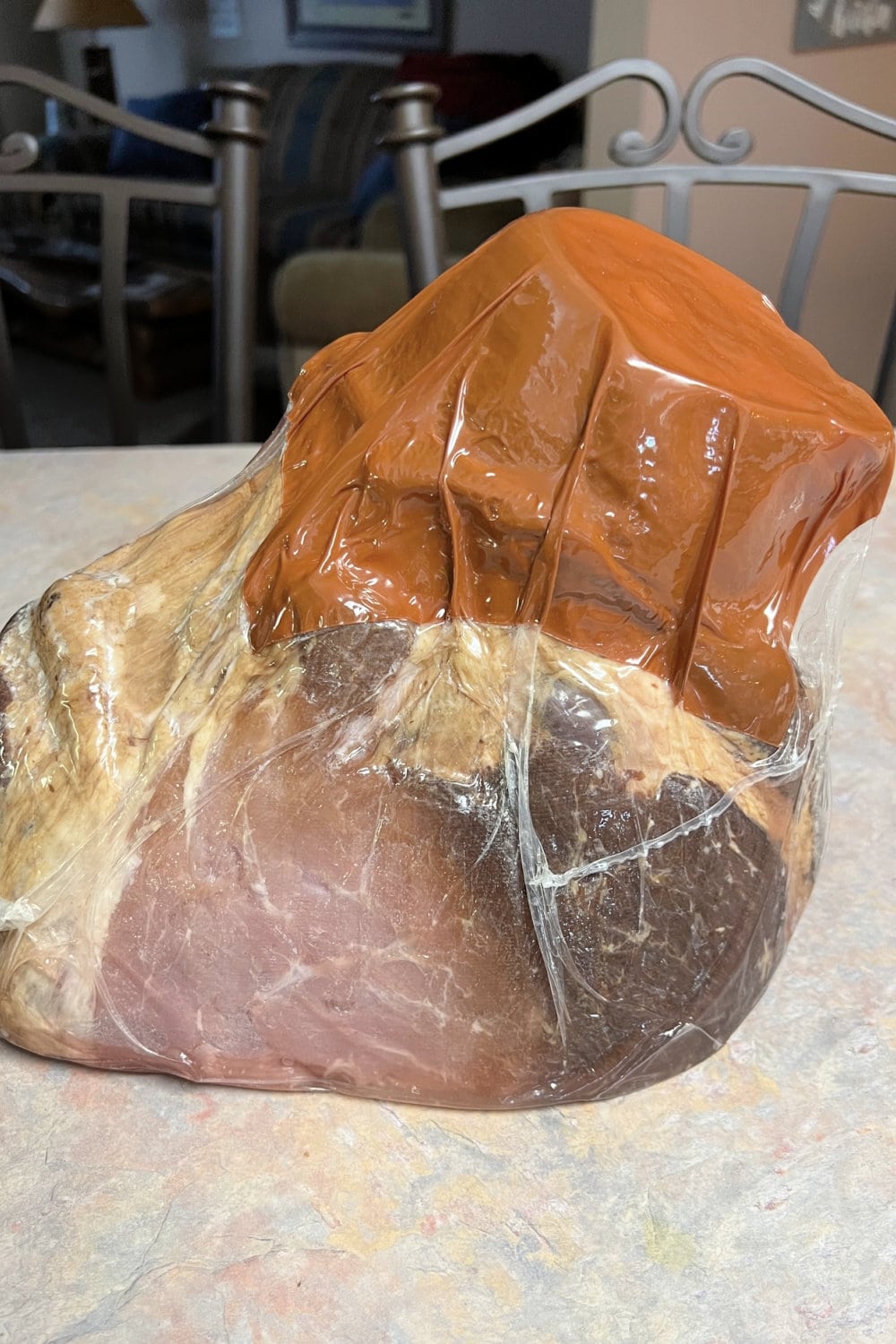
Half Hams
When you are looking at the half hams in the meat case, they can easily be identified by their shape.
The shank end ham is sometimes larger in size and more pointed in appearance due to the tapered leg bone that juts out at one end of the ham. If you are wanting to set a picture-perfect traditional holiday table, a shank end ham is best choice.
The butt end ham is very rounded on top with no bone protruding from one end like the shank end of the ham has. The butt end of the ham will have a center T-shaped bone that is visible on the cut side of the ham.
Because half hams are very popular and big sellers, these are the hams you’ll typically see piled high in the refrigerated meat bunkers during the holidays, usually sold at very reasonable prices at this time of year.
How to Choose: Shank End Ham vs Butt End Ham
There is considerable debate over which cut of ham is the best one – butt end or shank end.
And no matter which one you choose (butt end or shank end), they are both considered as very flavorful bone-in hams….meaning that each one has a bone at the very center.
At first glance, it might appear that the butt end ham will be easier to carve because it’s shape is round and uniform. I’ve found that the butt end hams tend to have more gristle and fat within the meat. But, because the butt-end hams are a more fatty cut, the meat is very tender, juicy, and rich.
The shank end of the ham tends to offer meat that is more lean but still flavorful. Because the center bone of the shank end ham is elongated and there is less connective tissue, many home cooks love the shank end ham because it is easier to carve for serving.
Most home cooks overwhelmingly believe (and I whole-heartedly agree) that bone-in hams are worth any extra work they require.
**You may want to try both cuts of half ham for yourself. We have found either one to be delicious!
What is a Bone-In Ham Exactly? Is a Bone-In Ham More Flavorful? Why?
A bone-in ham is exactly as it says: a ham with a bone in the center of it.
And both the butt end ham and the shank end ham that we described above are considered to be bone-in hams, just as spiral-sliced hams are.
As with any meat, the more bone that’s involved, the more flavor and texture the meat will have…ham is no different! The bone at the center if a good thing.
The added bonus of cooking a bone-in ham, is that the leftover ham gives wonderful flavor to soups, stews, and homemade broth.
When you’ve eaten all the ham, place the bone (along with any ham meat that is still clinging to the bone) into a freezer bag, then into the freezer to use at a later time.
You can also save any leftover ham to freeze and eat later, or add it to your pot of ham and beans that you make using the ham bone later.
Is There More Work Involved When Cooking a Bone-In Ham vs. a Boneless Ham?
Yes, and this is mainly due to the bone that is at the center of a bone-in ham. That bone at the center requires that you must slice around it, so carving is a bit more tricky and takes more time.
But, the extra work of having to slice around the center bone when carving ham is quickly forgotten once you put a piece of it in your mouth – delicious!
What is a Picnic Ham?
Ok, so here’s a little bit more ham confusion! You ready? Picnic ham is not technically HAM.
Picnic hams come from the lower part of a pig’s shoulder, not the rear end where real ham comes from. Yep, it’s true….picnic ham comes from the shoulder.
The name “picnic” refers to it’s common use in casual dining….such as a picnic!
Picnic hams are smoked (which means they are fully cooked), and this is what gives them the flavor of ham. But, because they tend to have more fat throughout the meat, they do need a bit longer in the oven to reach the desired fully-cooked, safe, and hot temperature at the very center, which is about 160 degrees F.
What is a Boneless Ham?
Just as the name says, a boneless ham does not contain any bone whatsoever. Before the ham is processed, the bone is removed. The best thing about boneless ham is the ease of slicing.
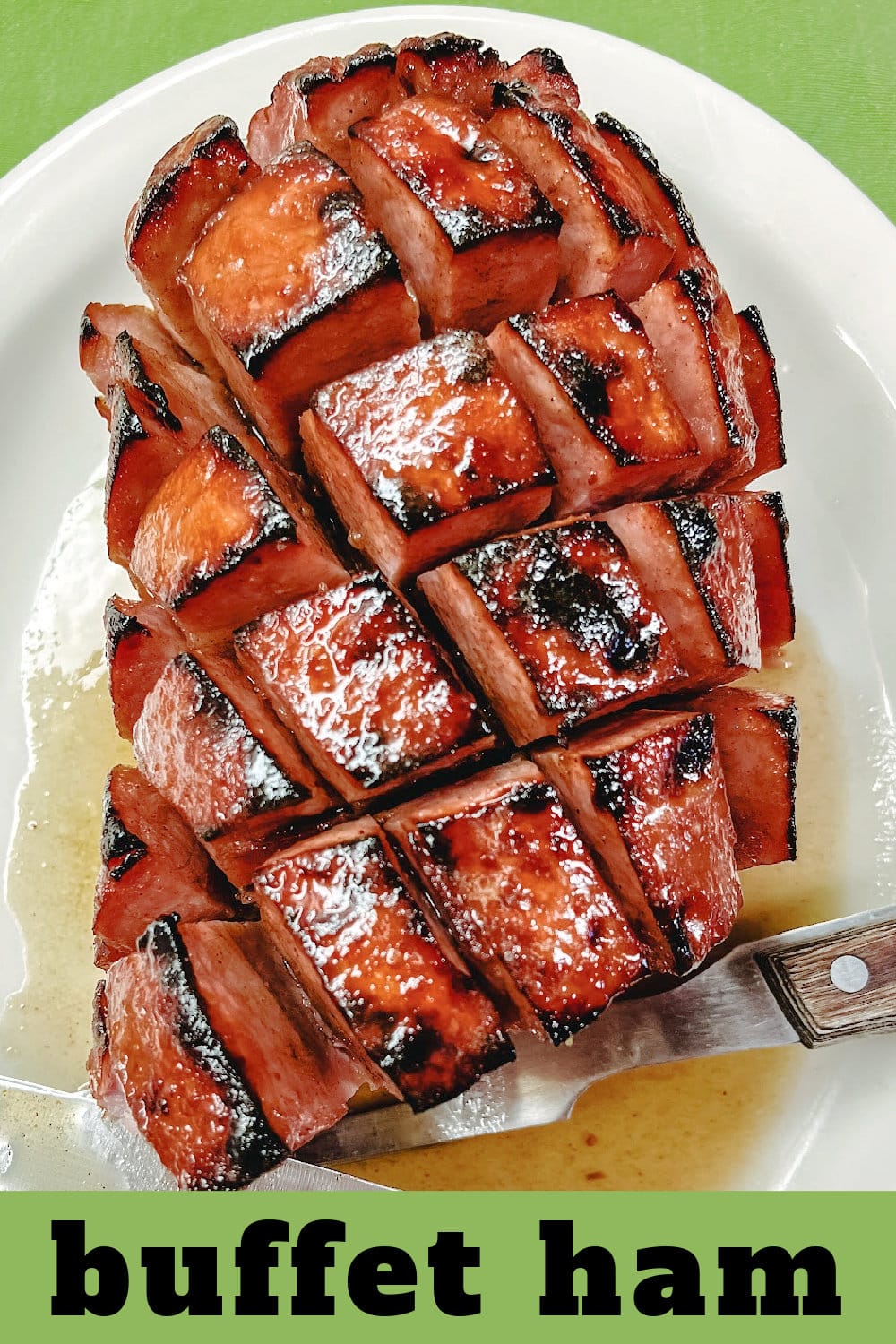
What is a Buffet Ham?
A buffet ham is an inexpensive type of boneless, precooked ham that is sometimes called a pressed ham.
A buffet ham is processed in a way that uses water and salt to press together several pieces of ham into one piece of meat.
Buffet hams are the hams that are very recognizable in the meat case at your grocer, since they are typically 4 pounds in weight (exactly) and are perfectly pressed into oval-shaped pieces of meat.
Because buffet hams don’t offer as much flavor as other hams, it’s good to bake and serve them with a sauce.
What is a Bone-Removed Ham?
There is such a thing as a bone-removed ham (sometimes just called a boned ham), though this is definitely specialty item that must be custom-ordered from a butcher shop or an on-line specialty ham company.
Should I Cook a Boneless (or Bone-Removed) Ham Before I Cook a Bone-In Ham?
I think cooking a boneless ham first is a great idea, especially if you are new to cooking ham. Boneless hams are easy to cook and easy to slice which gives you confidence.
And, once you feel successful having cooked a boneless ham, you’ll want to conquer cooking a bone-in ham.
**Some new-to-cooking cooks even like to start with the boneless buffet ham that we talked about above.
Whole Ham or Half Ham – How Can I Know Which One Should I Purchase?
Because not every gathering requires an entire whole ham, half hams are a great option.
The other thing to consider when deciding whether to purchase a whole ham or a half ham is what type of cooking vessel you have at home.
Do you have a roasting pan that is large enough to hold a whole ham? **You can roast a whole ham on a basic, rimmed cookie sheet, but it’s tricky since the sides aren’t very high.
Even if you are feeding a really big group, sometimes it’s better to purchase two half hams since they are easier to manage and don’t require such a large roasting pan.
**Whole bone-in hams usually weigh around 10-18 lbs. and feed 20-36 people. Half bone-in hams usually weigh in around 5-10 lbs. and feed 10-20 people.
How Much Ham Should I Purchase For My Dinner?
When figuring how much ham to buy, here’s a good rule of thumb:
For serving boneless ham, plan to purchase 1/3 -1/2 lb. per person.
For serving bone-in ham, plan to purchase 1/2 – 3/4 lb. per person, since bone-in ham is heavier. (You’ll need more ham per person since the bone is part of the ham.)
I always buy on the higher side per person because I want to make sure I have ham leftovers.
**Whole bone-in hams usually weigh around 10-18 lbs. and feed 20-36 people. Half bone-in hams usually weigh in around 5-10 lbs. and feed 10-20 people.
What is a Spiral-Sliced Ham?
A spiral-sliced ham is a cured ham that has been cut into horizontal slices that are still attached to the bone at the center of the ham.
Spiral-cut hams are pre-sliced as a convenience to home cooks since all you have to do is slice down through the slices, right where the ham connects to the center bone. Voila! Ham slices ready to serve.
So a Spiral-Sliced Ham is Considered a Bone-In Ham, Correct?
Yep. Any ham that has a center bone within it (like a spiral ham does) is considered a bone-in ham.
What are the Pros and Cons with Spiral-Sliced Ham?
Spiral-sliced hams do have a tendency to dry out very quickly when they are cooked. It’s easy to overcook a spiral-sliced ham because the pre-cut slices are very thin.
I recommend that spiral-sliced hams be covered with foil when cooked and that a lower oven temperature of 300 degrees F. be used.
Cooking a spiral-sliced ham at the lower temperature of 300 degrees F. allows the ham to get fully cooked to the center without over-cooking the slices at the outside of the ham. You can remove the foil during the last few minutes of the cooking time if you want the exterior of the ham to brown a bit.
How Do I Know if My Spiral-Sliced Ham is Over Cooked?
An overcooked spiral-cut ham is easy to spot. The slices will curl up and the meat is pretty chewy and dry. You’ll definitely know!
What is the Difference Between Cured Ham and Smoked Ham?
Cured Ham –
Regardless of the size and cut, the majority of hams sold in U.S. grocery stores are considered cured hams, unless they are specifically labeled otherwise.
The curing process is what gives ham its salty, smoky and distinctive taste. Hams are cured using a wet brine, a dry salt rub, or by smoking. Curing controls bacteria development that might occur later if the ham is smoked.
Nearly all cured hams sold in U.S. grocery stores are fully pre-cooked and only need reheated to serve. Cured hams are almost always marked on the label as “fully cooked” and/or “ready to serve”.
Think of a cured ham as the everyday type of ham – always readily available and usually fairly inexpensive as cuts of meat go.
Smoked Ham –
Before a ham is smoked (to infuse that smoky flavor many of us enjoy) it is almost always cured (cooked) first. Check the label to be sure if you question this.
To smoke a ham, it spends many hours, sometimes even days, in a smokehouse so the smoke essence of maple or hickory can slowly infuse into the meat at a very low temperature.
And because a smoked ham is also fully cooked (cured) at the time of purchase, it also just requires reheating until hot throughout to be served.
So What is Uncured Ham Then?
Some grocery stores will sell uncured ham but it is actually fully cooked, just like cured ham is. (A bit more ham confusion for ya….I swear!)
Uncured hams are cured with different nitrates than cured hams, so they’ve got a completely different flavor than a cured ham, as well as meat that’s a bit different in appearance – it will be a much a much lighter pink in color.
Is Uncured Ham the Same as Fresh Ham from a Butcher Shop?
No. And here is what I’d do if I were you: if you are purchasing what is called a “fresh ham” from a butcher shop, have a conversation about cooking the ham and specific clarification how to do so before leaving there.
Not always, but usually (at least here where I live in the Midwest), when you purchase a fresh ham from a butcher, it is not fully cooked (as the cured hams are) and will require more time in the oven before serving.
What About Canned Hams?
Canned hams are actually scraps of ham meat that are pressed together before going into the can to be steamed. Canned hams have a different texture than over hams and aren’t quite as flavorful but they do offer convenience.
Can I Freeze a Ham and Cook it Later?
Yes!!! That’s why it’s great when you hit a ham sale right after the holidays – big $$$ saved.
How Long Can I Keep a Ham in the Freezer?
Properly store in the freezer, a ham will maintain the best quality for 3-4 months, but will remain safe way beyond that time. I recommend a ham stay no longer than 6-8 months in the freezer, though I have cooked a ham once that had been in my freezer for one year with zero problems.
How do I Thaw a Frozen Ham?
It is always best to thaw any frozen meat in refrigeration so that the meat thaws slowly and stays at a safe chilled temperature at all times.
How Long Does it Take to Thaw a Frozen Ham?
Defrosting time depends on the size of the ham. I usually allow 4-5 hours hours of refrigeration thawing for every pound of boneless ham and 6-8 hours for every pound of bone-in ham, since the bone at the center makes thawing take a bit longer.
As an example, a 10 pound boneless ham will need approx. 40 hours (almost 2 full days) to thaw in refrigeration. A 10 lb. bone-in ham will need approx. 80 hours (about 3 1/2 days) to thaw in refrigeration.
Always allow yourself a little extra thawing time to be on the safe side. A fully thawed and unopened ham can stay in the refrigerator for 3-4 days after it’s thawed.
More Cuts of Ham Commonly Available at The Grocery Store
Ham Steaks – slices of cured ham, usually sold 1 slice per package weighing about 1 lb. Ham steaks are easy to cook and also cook very quickly.
Breakfast Ham – breakfast ham is actually just the very center of the ham steak where it’s very tender.
Ham Hocks – the ham hock is the area of the pig’s back leg that is just beneath the shank end of the ham. Ham hocks are typically sold fully cooked and are very flavorful since there is more bone in that cut of ham. (You will often see bean recipes that call for ham hock meat for this reason.)
How to Make Baked Holiday Sticky Ham Step-by-Step
**Print the full recipe from the RECIPE CARD at the bottom of this post

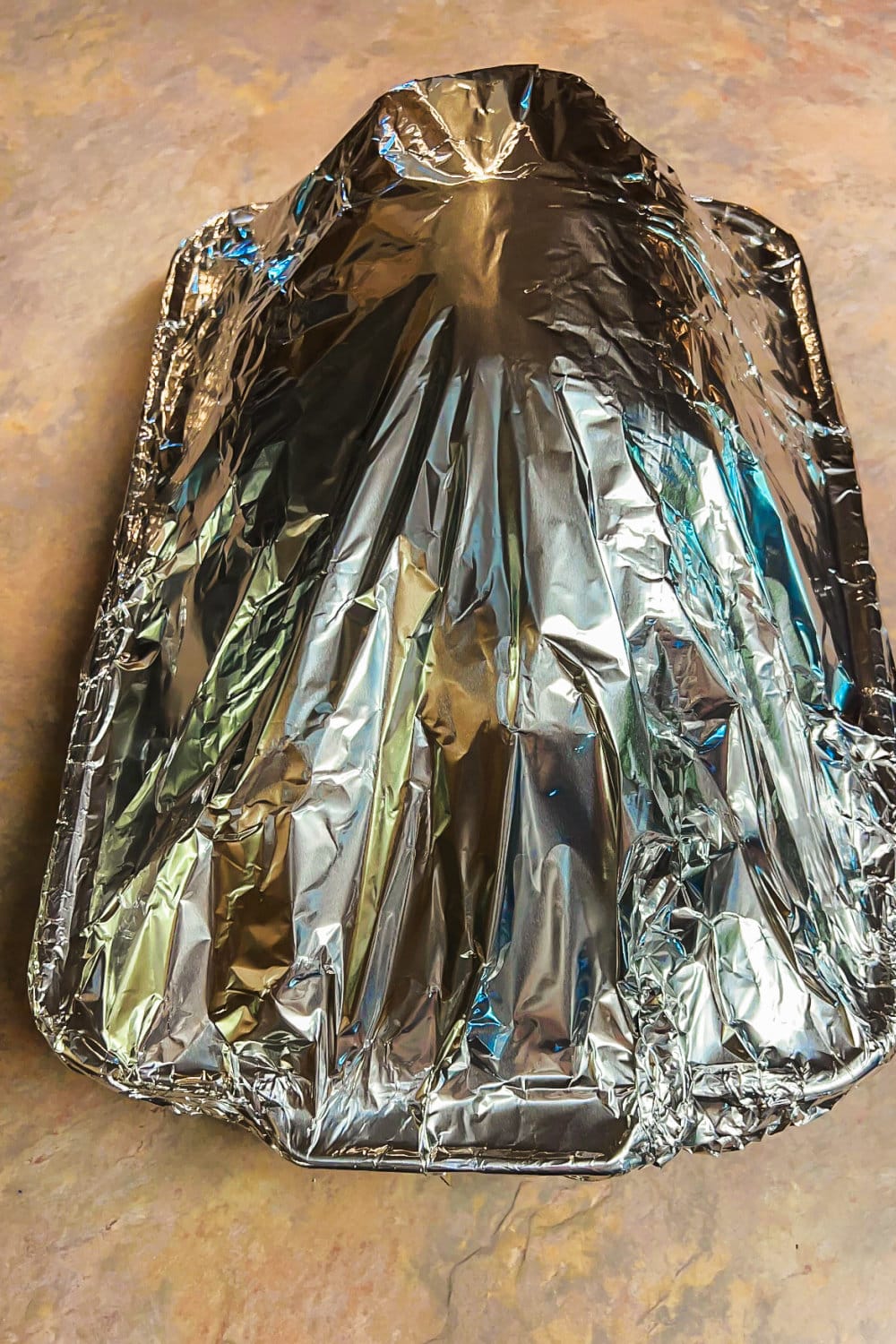
Unpackage the ham and place it into the roasting pan or baking dish, flat-side-down into the apple juice. Use a sharp utility knife to score the ham all across the entire surface, whether meat or fat, approx. 1-inch wide and 1/4-inch deep. Cover the ham with foil and place into the preheated 300 degree F. oven.

Bake the ham, covered, for 10 minutes per pound, or until it registers 140 degrees F. at the center of the ham when temped with an instant read meat thermometer. When the ham is fully cooked, pour one-third of the glaze over the top and return it, uncovered, to the oven at 425 degrees F. Bake for 10 minutes, then repeat the process twice more until the ham is sticky and luscious.
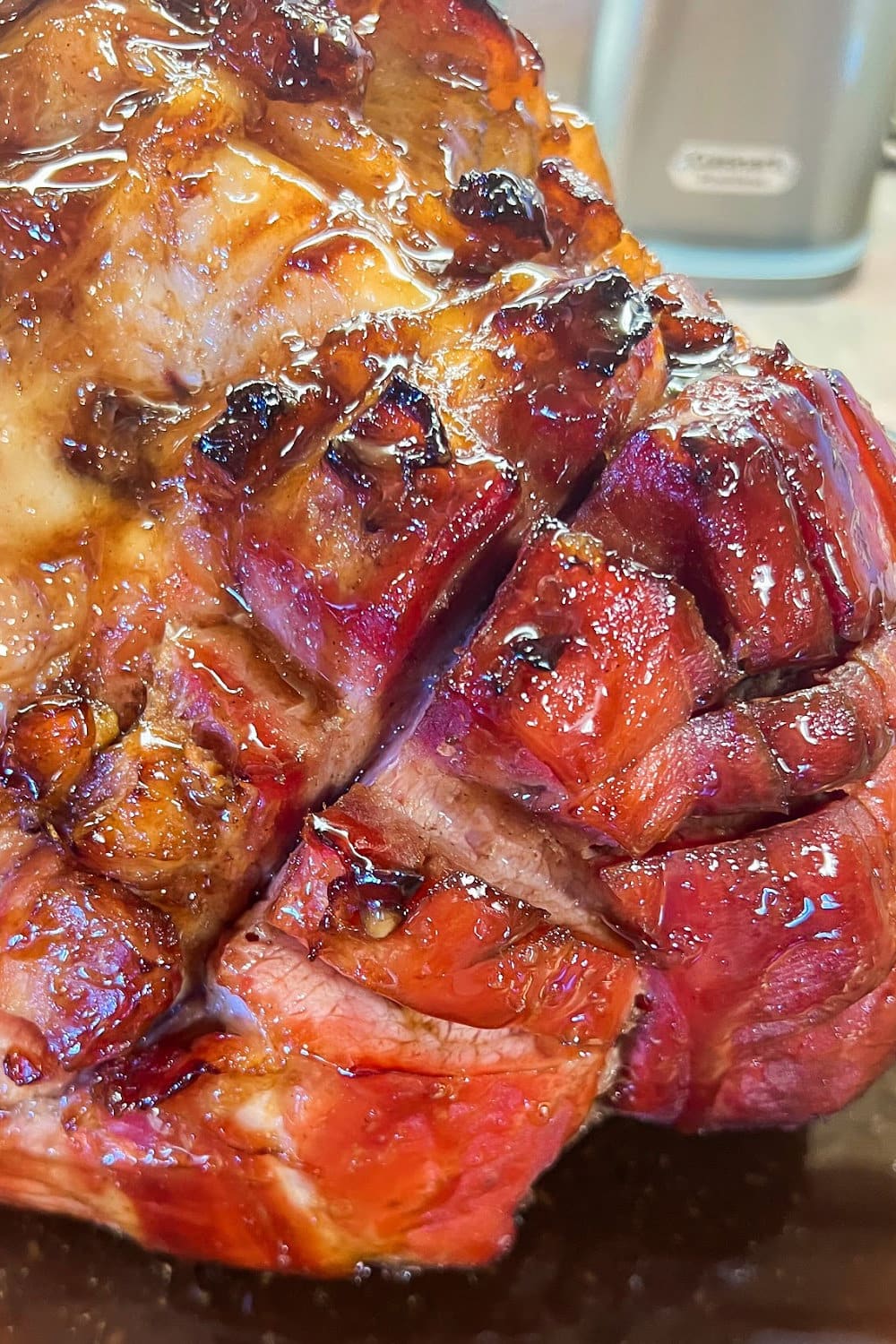

At this point, the ham should be caramelized, sticky, and luscious! Let cool slightly, then slice and serve. I love sauce, so I always double the recipe so I can have extra on the side.
Which tools are helpful for making and baking ham?
Roasting pan – a good roasting pan is something you’ll use again and again over the years. I like one with handles at each end that is about 13″ x 18″ in size. The heavier the roasting pan, the better it’s going to work for you – get one that’s made of good construction so that you get really good browning, no matter what you’re cooking. Also, never put your roasting pan in the dishwasher; always wash by hand so it lasts long and looks good.
Utility knife – a good, sharp utility knife works great for scoring the exterior of the ham. I really like my ceramic utility knife and also my stainless steel utility knife for this task.
Instant-read meat thermometer – Every cook should have an instant-read meat thermometer in the kitchen for temping any and all meats that are cooked, in my humble opinion. This is an ESSENTIAL tool that you will use again and again. In just a matter of seconds, you can find the internal temperature of any food you are cooking.
Wooden cutting board – for slicing the ham (and for slicing any other type of meat, as well) you’ll want a large cutting board that has a channel around the edge. The channel is where the juices from the meat can gather, keeping them from running off the cutting board and making a mess.
Chef’s knife – I use my stainless steel Wusthof chef’s knife for slicing meat, but some cooks prefer a good carving knife since the blade is a little more narrow.
Favorite Ham Recipes to Enjoy –
- Maple Pecan Glazed ham
- INSTANT POT GLAZED MAPLE AND ORANGE HAM
- HAM AND WHITE CHEDDAR CREPES
- GRANDMA LUCILLE’S HAM SALAD
- ELECTRIC PRESSURE COOKER HAM AND BEAN SOUP
- CHEDDAR AND HAM QUICHE
- EASY HAM AND CORN CHOWDER
Printable Recipe for How to Buy and Make the Best Holiday Sticky Ham

How to Buy and Make the Best Holiday Sticky Ham
Ingredients
Ham
- 10-12 lb. bone-in shank or butt ham, (This will be a fully cooked product when you purchase it from the grocer)
- 1/2 cup apple juice, may substitute orange, pineapple, or cranberry juice, whatever is on hand.
Glaze (Sticky Sauce!)
- 1 cup packed dark brown sugar
- 2 Tbs. mild molasses, preferably not black strap molasses since it is so strong, may substitute pure maple syrup, if needed
- 1/4 cup bourbon or whiskey, we prefer Wellers
- 1/3 cup honey
- 1 tsp. pumpkin pie spice
- 2-3 cloves garlic, crushed or minced
Instructions
- Preheat the oven to 300 degrees F.
- Remove the ham from the packaging, patting it dry with paper towels; let the ham rest for one-two hours, uncovered, on the counter. *Don't skip this step, if possible – your ham will cook much more evenly.
- Using a sharp utility knife, score the outside of the ham with diagonal cuts, about 1-inch apart in a criss-cross pattern over the top of the ham, scoring both the fat and the meat exterior about 1/4-inch deep.
- Add the apple juice to a roasting pan or very large baking dish (10×14 usually works fine for this size ham) To a roasting pan or large baking dish. Carefully place the ham flat-side-down into the juice; cover the ham tightly with a big sheet of heavy-duty foil.
- Place the covered ham into the oven on the center rack; bake for 10 minutes per pound, or until the ham registers 140 degrees at the center when temped with an instant-read meat thermometer.
- While the ham is baking, make the sticky sauce. Combine the brown sugar, molasses, bourbon, honey, pumpkin pie spice, and garlic in a saucepan over medium-high heat. Bring the sauce to a boil, then immediately reduce the heat to low, continuing to simmer the sauce for 5 minutes; remove from the heat and reserve. **If desired, double the sauce so that you have some for serving with the sliced ham, on the side.
- When the ham has finished cooking, remove it from the oven and uncover. Raise the oven temperature to 425 degrees F.
- Slowly pour about one-third of the prepared honey-bourbon sauce over the top of the ham, spreading it out over the surface and gently pressing it down into the ham where it's scored.
- Return the ham to the oven and bake, uncovered, for 10 minutes. When the timer sounds, remove the ham and pour another one-third of the sauce over the ham, then bake for another 10 minutes uncovered; repeat once more with the remaining one-third of the sauce. At this point, the ham should be beautifully caramelized on the exterior. Let the ham cool slightly before slicing.
Notes
Nutrition
We love hearing from our readers and followers, so leave us a comment if you’d like. If you don’t hear back from us shortly, know that we may not have seen your comment. Feel free to reach out to us by email: ChefAlli@ChefAlli.com.
Let’s Get You Cookin’,
Chef Alli
Please Note: We do use referral and affiliate links here for products and services that Chef Alli loves and recommends. We may receive a small compensation when you use these links. This really helps us keep the recipe blog moving forward. Thank you so much!

Can I use the sticky sauce on my spiral sliced ham in the roaster?
Hi Judy –
Yes, you sure can. Towards the end of the cooking time, raise the temp of the roaster to high, add the glaze then cook the ham a few minutes longer (covered) until it gets caramelized and sticky! Should work just fine. So glad you asked this question.
If you try this in the roaster, let me know!
Chef Alli